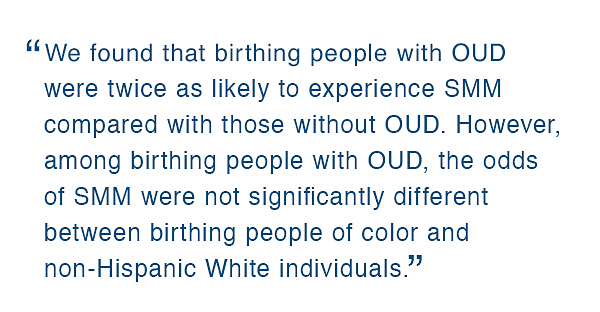DataMatters - January 2024 Edition Email

DATE: January 31, 2024

Happy New Year from CHIA! We hope that you all had a great holiday season and are enjoying a fruitful start to 2024.
In the “News You Can Use” segment, we walk through CHIA’s recently released quarterly dashboard updates on hospital inpatient and emergency department utilization using Case Mix data. Featured in the “Data User Profile,” researchers from the Betsy Lehman Center for Patient Safety explore the connection between severe maternal morbidity (SMM) among birthing people with opioid use disorder and examine whether differences in SMM exist by race and ethnicity.
Since CHIA last released DataMatters, we have announced the availability of the Massachusetts All-Payer Claims Database (MA APCD) for CY 2022. The MA APCD has been widely used to support policymakers, researchers, and the health care delivery system to analyze and report on population health management, quality outcomes, costs, and price variation. CHIA also published its most recent quarterly hospital and health system financial performance report, with data through September 30, 2023.
Last week, CHIA also held its first Oversight Council meeting of 2024. Watch the livestream of the meeting here.
We hope that you enjoy this newsletter and learn something new. As always, we welcome your feedback at newsletter@chiamass.gov.
News You Can Use
![]()
In this month’s newsletter, we wanted to shout out CHIA’s recent reporting on hospital inpatient and emergency department utilization. Since 2020, CHIA has produced annual and quarterly updates with analyses and trends on health care utilization in the Commonwealth sourced from the Case Mix databases.
Back in November, CHIA released its most recent quarterly updates, including data from October 2018 – June 2023. This most recent HIDD quarterly dashboard update includes a map detailing the rate of inpatient discharges by ZIP Code tabulation area and acute care hospital locations.
The EDD quarterly dashboard update includes several new enhancements, including reporting on ED visits characterized by patient race/ethnicity, primary payer type, age, and additional years of data showing utilization trends by patient ZIP Code tabulation area.
Recent findings show that HIDD discharges and EDD visits continue to fall below pre-pandemic levels, conversely, the average length of stay has remained higher than pre-pandemic levels (5 vs 5.5 days, respectively, for inpatient and 4.3 vs 5.5 hours for ED).
Releasing quarterly dashboards enables CHIA to provide more frequent and up-to-date insights into both inpatient and emergency department utilization in the Commonwealth. You can expect the next quarterly updates to be released in February 2024.
Data User Profile
Each DataMatters edition includes an interview with a user of CHIA data. This month we are excited to feature researchers from another state agency, the Betsy Lehman Center for Patient Safety (BLC). Godwin K. Osei-Poku, MD, DrPH, Associate Director of Research at the BLC, as well as Julia Prentice, PhD, Director of Research and Analysis also at the BLC—along with their co-authors—wrote Risk of Severe Maternal Morbidity in Birthing People With Opioid Use Disorder using CHIA’s Hospital Inpatient Discharge Data (HIDD).
Dr. Osei-Poku and his co-authors explored the connection between severe maternal morbidity (SMM) among birthing people with opioid use disorder (OUD) and examined whether differences in SMM exist by race and ethnicity.
We also want to extend our congratulations to Dr. Osei-Poku for being awarded the Charles E. Gibbs Leadership Prize for the best paper published in the journal Women's Health Issues in 2023.
CHIA is appreciative of the authors for taking the time to answer our questions in this month’s newsletter.
What was your research question? Why did you choose that question?
We examined severe maternal morbidity (SMM) among birthing people with opioid use disorder (OUD) and evaluated the extent to which differences in SMM exist by race and ethnicity. We were specifically interested in whether the race/ethnicity differences that have previously been reported in SMM exist within the population affected by OUD.
Which CHIA data do you use?
Case Mix (Hospital Inpatient Discharge Data [HIDD]– 2016 to 2020)
What was your experience using CHIA data?
We had a good experience using CHIA data. We use Case Mix in our regular work process and using it for this research project was seamless. We knew what variables and analyses to conduct having had prior experience with Case Mix. The different diagnosis code and procedure code variables were very helpful in identifying the specific indicators of SMM.
Please briefly describe your research and key findings.
We conducted a retrospective cohort study using HIDD for all births between 2016 and 2020. Our outcome measure was an indication of severe maternal morbidity (SMM) which is defined as “unexpected outcomes of labor and delivery that result in significant short- or long-term consequences to a woman’s health.” We identified SMM with 21 indicators of organ dysfunction including blood transfusion. We ultimately excluded blood transfusions, which were inconsistently reported by some hospitals during the study period.
Our particular area of interest was any diagnosis of OUD during the delivery hospitalization. We computed SMM rates for those diagnosed with and without OUD and examined the association between OUD and SMM after adjusting for patient and hospital characteristics including race and ethnicity using multivariable logistic regression analysis.
We found that birthing people with OUD were twice as likely to experience SMM compared with those without OUD. However, among birthing people with OUD, the odds of SMM were not significantly different between birthing people of color and non-Hispanic White individuals.

[We found that birthing people with OUD were twice as likely to experience SMM compared with those without OUD. However, among birthing people with OUD, the odds of SMM were not significantly different between birthing people of color and non-Hispanic White individuals.]
Which findings were particularly interesting or surprising for you?
We were surprised that we did not find higher odds of SMM in birthing people of color compared to white individuals among birthing people with OUD. Previous research had shown that birthing people of color have higher odds of SMM, and hence we expected a similar finding in the sample that was limited to just those with OUD.
What "takeaway" information would you like to highlight from your research and/or experience using our data?
A key takeaway from our research is the need for improved practitioner awareness and knowledge of best practices for treatments for birthing people with OUD given the higher risk of SMM with OUD, even after adjusting for other maternal and hospital characteristics. Our findings also emphasize the need to measure and track SMM as a quality metric together with implementing maternal safety bundles to improve outcomes and reduce the burden of SMM among birthing people with OUD.
Our analyses were possible since Case Mix data allows for robust assessment of the unique risk birthing people face during delivery. Case Mix (HIDD) contains all discharge records from all patients in Massachusetts allowing for this in-depth population level analyses.
Publications and Data Releases
Quarterly Hospital and Health System Financial Performance Report with Data through September 30, 2023
January 2024
MA APCD CY 2022 Data Release
December 2023
CHIA announced in December the availability of the most recent Massachusetts All-Payer Claims Database (MA APCD). The MA APCD Calendar Year (CY) 2022 release features data for January 1, 2018 - December 31, 2022, with claims run-out through June 30, 2023. The MA APCD contains data collected from private and public payers of eligible health care claims for Massachusetts residents.
Upcoming Events and Resources
Events and announcements of interest to our community, organized by CHIA, our data partners, and others
CHIA Data User Workgroups
Tuesday, February 27, 2024, 3:00 PM
These ongoing meetings are designed for data users and other interested parties to connect with CHIA to discuss analytical techniques and best practices in research using CHIA's MA APCD and Case Mix databases. The next virtual workgroup meeting will be on Tuesday, February 27, at 3:00 PM. For more information including past presentations and user support materials, visit the information page. To learn more about CHIA data, please visit https://www.chiamass.gov/chia-data/.
Massachusetts Health Policy Commission
Benchmark Hearing
Wednesday, March 14, 12:00 PM
The HPC holds a public hearing to determine whether the health care cost growth benchmark should be adjusted for calendar year 2025. Under the framework set forth in Chapter 224, from 2023 through 2032, the health care cost growth benchmark will be set equal to potential gross state product (PGSP), or 3.6%, unless the HPC determines that an adjustment to the benchmark is reasonably warranted.
CHIA Oversight Council Meeting
Wednesday, March 20, 2024, 2:00 PM
CHIA’s appointed Oversight Council meets quarterly to discuss agency priorities and agenda-setting. The next meeting is scheduled for Wednesday, March 20, 2024 2:00 p.m. and will stream live on CHIA’s YouTube channel.
National Academy for State Health Plans (NASHP) 37th Annual Conference
September 9-11, 2024
Nashville, TN
Join hundreds of state leaders from all 50 states and DC, as #NASHPCONF24 brings attention to the most timely, cutting-edge issues facing state health policymakers, and highlights innovative solutions shared by the nation’s leading experts on topics including: lowering prescription drug costs, hospital costs, Medicaid, health insurance marketplaces, telehealth, social determinants of health, behavioral health, and more.
American Public Health Association (APHA) Annual Meeting Expo
October 27-30, 2024
Minneapolis, MN
The 2024 APHA Annual Meeting and Expo will take place in Minneapolis, MN on Oct. 27-30, 2024. The annual conference provides high-quality, science-based education, engaging networking opportunities, and cutting-edge resources to thousands of public health professionals from across the nation. Registration and housing will open in June 2024. This year’s theme is “rebuilding trust in public health and science.”
The submission deadline for research extracts is Friday, March 29! Submissions related to all areas of public health are welcome, but abstracts related to the 2024 meeting theme are encouraged.
Massachusetts Association of Health Plans (MAHP) 2024 Annual Conference
SAVE THE DATE! Friday, November 15, 2024
MAHP will be holding next year's conference at the Seaport Hotel on November 15th. Individual registrations will open in June. Please reach out to Ann Chamberlin at chamberlin@mahp.com to get information on sponsorship opportunities.
Join Our Team
A selection of open positions at CHIA. Please feel free to share broadly with your network. Follow CHIA on LinkedIn for more regular updates.
Privacy and Compliance Specialist
Legal Team
CENTER FOR HEALTH INFORMATION AND ANALYSIS
www.chiamass.gov
